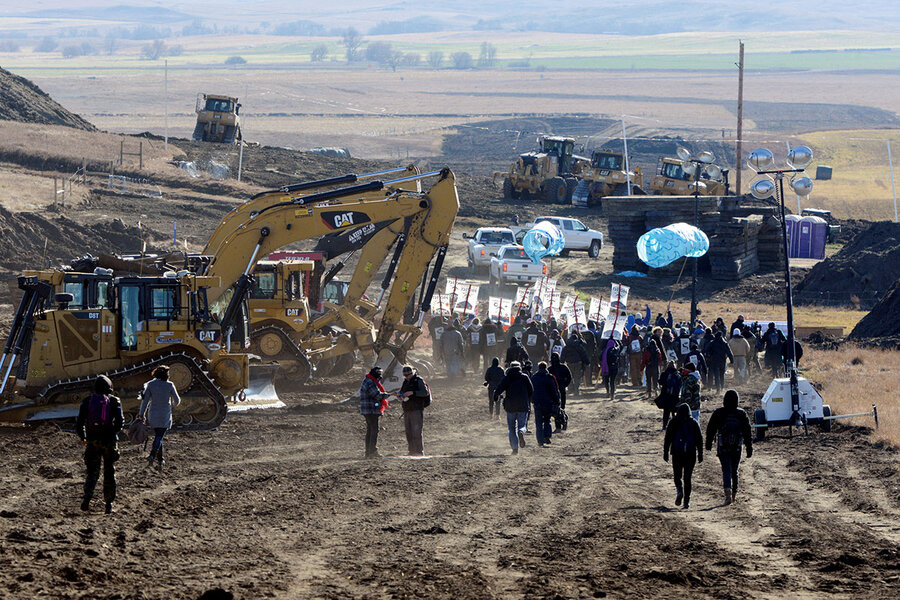Trump signs executive orders advancing Keystone, Dakota pipelines
Loading...
Update: This story was updated at 5:15 p.m.
President Trump continues to undo portions of former President Obama’s legacy, including on Tuesday approving construction of two pipelines that Mr. Obama had blocked.
In his fourth day in office, Mr. Trump gave government approval to the Keystone XL and Dakota Access Oil pipelines, a pair of projects that Obama had halted for environmental and other reasons, the Associated Press reports.
The decision delivers a political blow to environmental groups that have been opposing the Keystone XL project for years.
In November 2015, Obama formally rejected the Keystone XL pipeline, citing the need to curb reliance on climate-warming fossil fuels.
”America’s now a global leader in taking serious action to fight climate change," Obama said at the time. "And frankly, approving this project would have undercut that global leadership. And that's the biggest risk we face, not acting.”
First proposed in 2008, the 1,179-mile pipeline is designed to carry 800,000 barrels of crude oil a day from Saskatchewan to Nebraska by way of Montana and South Dakota. In Nebraska, Keystone XL connects to the existing Keystone pipeline, which continues down to the Gulf of Mexico.
The company claims the project will lower gas prices and create thousands of jobs.
Environmental groups oppose the pipeline, which would transport oil extracted from Alberta's tar sands. Thousands of protesters staged sit-ins outside of the White House in the summer of 2011.
Because the project crosses international borders, it falls under foreign affairs, so it requires a federal permit from the president.
An unrelated pipeline, the Dakota Access Pipeline slated to run from North Dakota to Illinois, also captured national attention last year after the Standing Rock Sioux tribe said the pipeline threatened its drinking water and sacred sites. Thousands of people across the country traveled to the camps to join the protests.
Though the project has already mostly built, the tribe and the protesters saw a victory in December as the Army Corps of Engineers formally declined to allow completion of the $3.7 billion pipeline and pledged to look at alternative routing.
The Christian Science Monitor noted at that time:
“The protesters' fight isn’t over, but winning a halt to the existing route has undeniably emboldened them. And, although it’s too soon to know, it appears possible that they have not only drawn sympathy and support from beyond the Great Plains, they may also be inspiring a new generation of environmental activism from Indian country to the political left.”
It remains unknown what Trump’s decision means for the rerouting plan. But Trump's approval of the pipelines do open the president to accusations of conflict of interest
Trump publicly endorsed the Keystone XL project in 2011, citing its benefits in job creation and lower gas prices. According to a financial disclosure, he has also invested a quarter of a million dollars in the Canadian builder of the pipeline.
Similarly, Trump also appears to have financial interests in the Dakota Access Pipeline Project, the Monitor reported.
“He once owned between $500,000 and $1 million of shares in Energy Transfer Partners, the Dallas-based company building the pipeline, but has since sold the shares, his spokeswoman Hope Hicks said. And as of his most recent disclosure statement in May, he owned $100,000 to $250,000 of stock in Phillips 66, which has a 25 percent stake in the pipeline, The Washington Post reported.”
Trump's action comes one day after he formally withdrew the United States from the Trans-Pacific Partnership trade deal, as he had promised to do on the campaign trail.
The pipelines have brought together an unusual coalition, and this move will likely be applauded by Republicans, oil producers, and union groups who see oil and gas development as a source of jobs and economic growth.
This report includes material from the Associated Press and Reuters.






